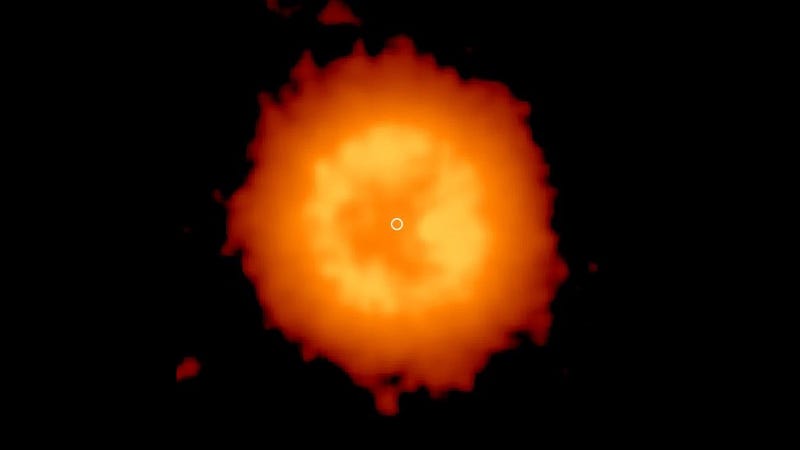 The nebula containing the strange objectImage: Gvaramadze et al (Nature (2019))
The nebula containing the strange objectImage: Gvaramadze et al (Nature (2019))
Astronomers have observed evidence of a hot, spinning star blasting winds outwards at 10,000 miles per second, which seemed to have formed from a relatively recent collision of white dwarf stars. It’s some of the clearest evidence to date of these stars colliding and merging.
White dwarfs are incredibly dense, glowing remnants of dead stars. When pairs of white dwarfs coalesce, researchers expect something called a type 1a supernova, or large stellar explosion to occur. But in this case, the object didn’t explode—it just produced mind bogglingly-quick stellar winds. Results like these help scientists understand supernovae and white dwarf stars more generally.
“First of all, [these results show] that white dwarf mergers happen,” study co-author Götz Gräfener, an astronomer at the University of Bonn told Gizmodo. “And secondly, it shows that some of these mergers don’t explode.”
The researchers were specifically searching for infrared-emitting clouds of gas and dust surrounding stars when they discovered this object, around 10,000 light years away, in the constellation Cassiopeia, using data from the Wide-field Infrared Survey Explorer space telescope. They named the object J005311, and observed it again using a six-meter telescope at the Special Astrophysical Observatory of the Russian Academy of Science. They measured the brightness and the spectrum—the different wavelengths of light—emitted by the object in order to determine what was going on.
J005311 is around 40,000 times brighter than the Sun, and based on its emission lines, the scientists were able to infer that it is extremely hot, around 200,000 degrees Kelvin (around 360,000 Fahrenheit) spewing stellar winds at 16,000 kilometers per second, around 10,000 miles per second. And surprisingly, it seemed to be missing both hydrogen and helium. These properties agree well with theories about how a merged pair of white dwarfs should look, according to the paper published Monday in Nature.
And if that’s true, scientists could be looking at the precursor to a supernova. At the calculated mass, the object would turn into a low-mass neutron star and then explode in what’s called a type 1c core-collapse supernova, according to the paper. This is interesting and different from what scientists expect—that white dwarfs colliding with other stars should turn into type 1a supernovae.
 The nebula in the infrared (a,b) and in the optical (c)Image: Gvaramadze et al (Nature (2019))
The nebula in the infrared (a,b) and in the optical (c)Image: Gvaramadze et al (Nature (2019))Other scientists were excited to see the paper. “As far as I can tell, the white dwarf merger interpretation meshes well with the observations,” Josiah Schwab, a theoretical astrophysicist at UC Santa Cruz, told Gizmodo in an email. “The wind velocity is remarkable and I think it will be important for future observations to try to test the magnetic scenario proposed in the paper.” Gräfener also told Gizmodo that taking a direct measurement of the object’s magnetic field is one of the team’s future goals.
Researchers can’t be 100 percent sure that they’re looking at the result of merging white dwarfs—it might just be a massive star that’s lost a lot of its material, though that interpretation doesn’t match the data, said Gräfener.
But still, it’s an extreme object, and it could continue to reveal the true nature of the chaotic things that occur throughout our Universe.
Share This Story